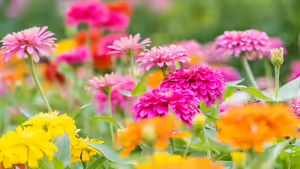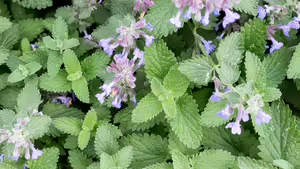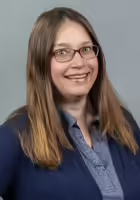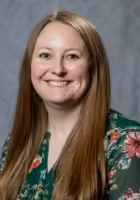Title
Wellness in Nature
Spending time in nature can benefit mental and physical well-being. From creating a sensory experience while growing vegetables and fruits in a garden, to hiking and exploring a forest preserve, even a short amount of time spent in nature can improve overall health.
- Be present and aware in the moment.
- Observe the world around you.
- Appreciate the natural environment you are in.
Explore the health benefits of being present in nature and discover simple activities to foster experiences in the natural world with Wellness in Nature resources developed by Illinois Extension Family Life and Horticulture educators.
Connect with Nature
Benefits of Spending Time in Nature
Besides nature helping us connect to something larger than ourselves, research finds many benefits to being outside or just around green spaces. An extensive list of journal articles highlighting research on what could be called "ecotherapy" showed that being in nature can:
- Significantly improve mild depression through walks and gardening
- Decrease rumination and aggressiveness
- Increase one's ability to think about and solve personal problems and improve creative problem-solving
- Reduce stress and anxiety
- Reduce instances of diabetes, infectious diseases, cancer, obesity, cardiovascular disease, musculoskeletal complaints, migraines, and respiratory disease
Some programs and studies target veterans with PTSD, teenagers with addictions, relationship issues, low self-esteem, and children with ADD/ADHD, which have had positive results with natural interventions.
The World Health Organization identifies stress and low physical activity as two of the leading contributors to premature death in developed nations. Could nature be the answer when exposure to nearby nature can effectively reduce stress, or simply having a view of nature produces recovery benefits?
Anyone can practice mindfulness in nature – the key is simply to get outside! It doesn’t have to be a forest; a nearby park or even your backyard can work. Turn off your phone, take your time, and soak in the peace or the natural sounds around you. Engage all your senses – notice what you see, hear, and feel. Be present in the moment, focusing on your surroundings and appreciating the experience. You might also choose to meditate, journal, or sketch during this time.
Stimulate Your Senses
Think about the last time you just sat in your garden, breathing in the fresh herbal scents, listening to the naturally occurring sounds, and enjoying the arrangement of colorful blooms and foliage. The garden is a wonderful place to stimulate our senses, which in turn promotes our physical health and well-being.
Use all five senses to connect with nature to encourage awareness of our surroundings and heighten responses to them. Being mindful in the garden gives people more appreciation for life, improves our focus and attention, and improves our cognitive function and well-being.

Sight
Contrasting color, texture, light, shadow, and form in the garden can all stimulate our sense of sight. Warm colors, like red, orange, and yellow, are energizing, while cool colors, like blue, purple, and white, are relaxing. The plants selected should be both stimulating and calming. Bright mixes of garden zinnias (Zinnia elegans) or giant yellow sunflowers (Helianthus annuus) towering above the garden make for an invigorating pop of color, and both will attract beautiful butterflies to the garden.

Smell
The sense of smell is often the strongest human sense, with the potential to bring back specific memories and experiences to individuals. Some plants release scent naturally without the need for touch, such as roses (Rosa), while others do not release a scent until they are rubbed or crushed, such as geraniums (Pelargonium or Geranium). Catmint (Nepeta mussinii), a hardy perennial that produces pale purple flowers from May to September, releases a light lavender-like scent when the leaves are rubbed.

Sound
Some sounds in the garden occur naturally—wind blowing through the plants, or leaves crunching beneath our feet. Wind chimes and water fountains can add a calming sound, as well. Bird feeders and baths can attract our feathered friends to visit the garden to play their songs. Ornamental grasses, like switchgrass (Panicum virgatum), rustle in the wind. Dried seed pods on false blue indigo (Baptisia australis) can make natural maracas as the seed rattles against the hard pod.

Taste
A variety of fruits, vegetables, and herbs can be added to a sensory garden to explore tastes in the garden. Edible flowers, including nasturtium and pansy, also make tasty additions. Before eating or consuming, be sure to clearly identify which plants are edible in the garden.

Touch
Offer a range of textures to explore, such as rough, smooth, fuzzy, and even sticky, through plant bark, foliage, flowers, seeds, and fruits. Choose tough plants that can handle frequent handling. A popular choice for a fuzzy leaf plant is lamb's ear (Stachys byzantina). Before touching, clearly identify plants in nature to avoid and those that may cause skin irritation.
Title
Sensory Gardens
A sensory garden is thoughtfully designed to include and arrange specific plants to engage and stimulate one or more of the five senses: sight, smell, sound, taste, and touch. While often geared toward young children, sensory gardens can be enjoyed by all ages. They can also be therapeutic for individuals with developmental or physical disabilities, sensory processing disorders, or cognitive challenges.
Just like with any garden, when selecting perennial plants, make sure that they are hardy to your area and of assorted colors, heights, textures, and bloom times. To ensure safety in the garden, plants should be non-toxic, and pesticides should not be applied. A sensory garden is a perfect place for anyone to explore their senses, learn about plants, and connect with our natural world.
Ready to Learn More?
Connect with an Extension Expert

Jennifer Fishburn

Brittnay Haag

